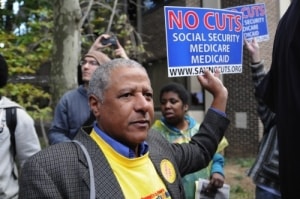What Journalism USED to be…
Reading so much main-stream media coverage of Social Security and Medicare (or truly lack thereof) each day has honestly proven to be a very depressing experience. The Washington echo-chamber is clearly in full force these days (remember the run-up to the Iraq war?) and anti-Social Security foes appear to be reaping the rewards of a $Billion dollar investment.That’s why reading a story that actually shows some historical memory, independent thought and analysis beyond quotes offered in the latest Pete Peterson funded News Release is a welcome breath of fresh air.Put this Salon story at the top of you “must share” list today!
How the rich created the Social Security ?crisis?
Now and then, George W. Bush told the unvarnished truth?most often in jest. Consider the GOP presidential nominee?s Oct. 20, 2000, speech at a high-society $800-a-plate fundraiser at New York?s Waldorf-Astoria. Resplendent in a black tailcoat, waistcoat and white bow tie, Bush greeted the swells with evident satisfaction.?This is an impressive crowd,? he said. ?The haves and the have-mores. Some people call you the elites; I call you my base.?Any questions?Eight months later, President Bush delivered sweeping tax cuts to that patrician base. Given current hysteria over what arecent Washington Post article called ?the runaway national debt,? it requires an act of historical memory to recall that the Bush administration rationalized reducing taxes on inherited wealth because paying down the debt too soon might roil financial markets.Eleven years later, the Post warns in a ballyhooed article, reading like something out of Joseph Heller?s ?Catch-22,? that Social Security?the 75-year-old bedrock of millions of Americans? retirement hopes?has ?passed a treacherous milestone,? gone ?cash negative,? and ?is sucking money out of the Treasury.?Anybody who discerns a relationship between these events, that is, between a decade of keeping the ?have-mores?? yachts and Lear jets running smoothly and a manufactured crisis supposedly threatening grandma?s monthly Social Security check must be some kind of radical leftist.That, or somebody skeptical of the decades-long propaganda war against America?s most efficient, successful and popular social insurance program. It?s an effort that?s falsely persuaded millions of younger Americans that Social Security is in its last days and made crying wolf a test of ?seriousness? among Beltway courtier-pundits like the Post?s Lori Montgomery, who concocted an imaginary front page emergency out of a relatively meaningless actuarial event.All in service, alas, of a single unstated premise: The ?have-mores? have made off with grandma?s money fair and square. They have no intention of paying it back. That?s the only possible interpretation of the Post?s admonition that ?the $2.6trillion Social Security trust fund will provide little relief. The government has borrowed every cent and now must raise taxes, cut spending or borrow more heavily from outside investors to keep benefit checks flowing.?Little relief? In fact, the law?s working precisely as intended. After 28 years of generating huge payroll tax surpluses to cover the baby boomers? retirement benefits, the system must now begin to draw upon those funds to help pay current benefits?the vast majority still covered by current payroll tax receipts.?Rather than posing any sort of crisis,?explains Dean Baker of the Center for Economic and Policy Research, ?this is exactly what had been planned when Congress last made major changes to the program in 1983 based on the recommendations of the Greenspan commission.?Again, this is the beneficiaries? money, invested by the Social Security trustees in U.S. Treasury bonds drawn upon ?the full faith and credit of the United States.? Far from being ?meaningless IOUs? as right-wing cant has it, they represent the same legally binding promise between the U.S. government and its people that it makes with Wall Street banks and the Chinese government, which also hold Treasury Bonds.A promise not very different, the Daily Howler?s Bob Somerby points out, from the one implicit in your bank statement or 401K (if you?re lucky enough to have one). Did you think the money was buried in earthen jars filled with gold bullion and precious stones?Raise taxes, cut spending or borrow? What other options does the U.S. government, or any government, have?On his New York Times blog, Paul Krugmandissects the Catch-22 logic behind the Post?s bogus crisis. You can?t simultaneously argue ?that the trust fund is meaningless, because SS is just part of the budget, then claim that some crisis arises when receipts fall short of payments, because SS is a standalone program.? For practical purposes, it?s got to be one or the other.So is Social Security a ?Ponzi scheme?? No, it?s group insurance, not an investment. You die young, somebody else benefits. Its finances have been open public record since 1936. Do fewer workers support each beneficiary? Sure, but who cares? It?s denominated in dollars, not a head count. The boomers were nearing 40 when the Reagan administration fixed the actuarial tables. No surprises there.Are longer life expectancies screwing up the numbers? Not really. Most of the rise is explained by lower infant and child mortality, not by old-timers overstaying their welcome. Kevin Drumpoints out that gradually raising the payroll tax 1 percent and doubling the earnings cap over 20 years would make Social Security solvent forever.But that?s not good enough for the more hidebound members of the $800-a-plate set. See, over 75 years Social Security has provided a measure of dignity, security and freedom to working Americans that just annoys the hell out of their betters.
–Arkansas Democrat-Gazette columnist Gene Lyons is a National Magazine Award winner and co-author of “The Hunting of the President” (St. Martin’s Press, 2000). You can e-mail Lyons at [email protected].More Gene Lyons
Welcome to the Washington Post?s Halloween Social Security Scare Fest
The Washington Post continues its campaign against Social Security with an especially slanted, error-laden and opinion-filled story posing as a front page ?news? story.There are so many errors in this piece, even beyond the inherent bias of its approach, loaded language and slanted interviews, it would take a 5,000 word opus to highlight them all here. As a start, here is our President/CEO, Max Richtman?s letter to Washington Post editors (which will of course never be published so you will only see it here):
Dear Editor:On behalf of millions of Americans who have worked for and earned their Social Security benefits, I take strong exception to Sunday?s front-page piece by Lori Montgomery titled ?Social Security adding billions to U.S. budget woes.? This story is so riddled with factual inaccuracies and biased rhetorical flourishes it has no business in the news section of a major, or that matter, any newspaper.The entire premise of the piece is built on a foundation of falsehoods that have been perpetrated for decades by those who oppose Social Security with virtually no balance provided for the reader. Bias reported as fact is the hallmark of this story. For example, Social Security?s short-term shortfall is not a ?treacherous milestone,? but indeed a natural consequence of the programs? funding mechanism. Surpluses have been built up in Social Security since the last major reforms in 1983 precisely so funds would be available to pay benefits of the baby boom generation as they began retiring. This is also not the first time Social Security has paid out more in benefits than it is collecting in payroll tax revenues ? similar situations occurred in 1958, 1959, 1961, 1962, 1965, 1975, 1976, 1977, 1978, 1979, 1980, 1981, 1982, 1983 and in 2009. The world obviously did not come to an end on any of those occasions.Social Security?s Trust Funds, which Ms. Montgomery so cavalierly dismisses, are invested in U.S. Treasury bonds. Redeeming these bonds to pay benefits will require precisely the same choices the United States faces whenever any bond holder opts to cash in their bonds. In such cases, the government ?must raise taxes, cut spending or borrow more heavily from outside investors? ? there is nothing unique about these alternatives as they apply to Social Security. And if Social Security sells some of its bonds and this money is used to pay benefits, it does not raise the debt subject to the federal borrowing limit by a single penny. Claiming that somehow using Trust Fund assets to pay retiree?s benefits adds to the deficit shows a lack of understanding of fundamental economic concepts that borders incompetence.I do not have the space to identify the myriad other errors in Ms. Montgomery?s story. However I feel compelled to make one final point. The ?upper-income workers? who would suffer benefit cuts in the Bowles-Simpson deficit reduction plan (not the Commission they headed, which failed to adopt their recommendations) are people with average lifetime earnings of only about $40,000 a year. Labeling these hard working middle class Americans ?upper-income? in a Social Security discussion while at the same time the Washington Post questions whether someone earning $500,000 a year is truly ?wealthy? in the tax context seems especially hypocritical. I should also point out that the Bowles-Simpson plan requires the draw-down of the Trust Funds, thereby leaving Social Security in the same ?cash negative? situation Ms. Montgomery criticizes for the next half-century.I strongly urge the Washington Post to limit its editorializing to the appropriate editorial pages and stop disguising opinion as news reporting.Max Richtman, NCPSSM President/CEO
There have also been a number of good rebuttals and fact-checking responses online today. Richard Eskow reminds us how the Washington Post helped drive us to war with similar PR pieces, short on facts and high on political rhetoric posing as news. Now, it appears seniors are the target:
The piece’s author sits us down by the campfire, holds the flashlight up to her chin, and spins a yarn filled with quotes from right-wing ideologues from both parties. Most of her “sources” have a long history of trying to gut Social Security, often under the employ of billionaire former Nixon Cabinet member Pete Peterson (whose own organization, Fiscal Times, provides financial journalism services for the Post. Coincidence? You decide.)How many quotations are included from the organizations and groups defending Social Security? None.How many quotations from economists like Paul Krugman, Joseph Stiglitz, and Dean Baker, who have a proven record of accuracy of domestic economic matters? None.How many quotations from truly nonpartisan observers like Harry C. Ballantyne, the Chief Actuary for Medicare and Social Security appointed by Ronald Reagan who co-authored a report that put the lie to many of these claims? None.A director of the AARP is quoted, but only so that he can be characterized as the spokesperson for an “interest group” conducting a “public relations campaign.”Reporting like this makes Judy Miller look like John Peter Zenger.
Eskowalso provides a point-by-point breakdown of the Post errors here.CEPR Economist Dean Baker and New York Times contributor and Nobel Prize winner Paul Krugman also provide excellent descriptions of just how wrong this Post article truly is.
Apparently All the Super Committee Can Agree On is America’s Seniors Should Pay for Deficit Reduction
The new deficit reduction plan being proposed by some Democrats on the Super Committee proposes even more Medicare and Medicaid cuts than the draconian Bowles-Simpson plan and even less in revenue increases. Yes, you read that right?this is a Democrat?s plan. The Center on Budget and Policy Priorities has this analysis:
The new deficit-reduction plan from a majority of Democrats on the congressional Joint Select Committee on Deficit Reduction (the “supercommittee”) marks a dramatic departure from traditional Democratic positions ? and actually stands well to the right of plans by the co-chairs of the bipartisan Bowles-Simpson commission and the Senate’s “Gang of Six,” and even further to the right of the plan by the bipartisan Rivlin-Domenici commission. The Democratic plan contains substantially smaller revenue increases than those bipartisan proposals while, for example, containing significantly deeper cuts in Medicare and Medicaid than the Bowles-Simpson plan. The Democratic plan features a substantially higher ratio of spending cuts to revenue increases than any of the bipartisan plans.
And just to show you how dysfunctional Washington has become–even with some Democrats serving up middle-class Americans to take an outrageous $475 billion in cuts to healthcare programs, billions more in Social Security benefit cuts through a changed COLA formula, and fewer revenue increases than other so-called ?bi-partisan? plans–it?s still not enough for Republicans who want seniors programs cut even more and no new revenue.All this leads many to wonder, what are these Super Committee Democrats thinking? Richard Eskow wrote this on Huffington Post:
These proposals aren’t just destructive. They’re self-destructive. Pick a poll, any poll, and you’ll see how unpopular these ideas are. Overwhelming majorities of Americans – including a majority of Republicans – oppose cutting Social Security or Medicare to fix the deficits. And strong majorities want higher taxes on the wealthy, a topic which the Super Dems are waffling about.It’s a political kamikaze stunt for Dems to adopt the GOP’s “less government” theme. Ask yourself: If you want some government-cutting done, are you going to hire a Democrat or a Republican? If you want to fire government workers, are you going to hire Mitt Romney – who has a long track record of firing people – or Barack Obama? Every minute spent bragging that “we’ll cut more” is a minute spent convincing people to vote for your opponent. The President’s repeating the mistakes he made during the healthcare and financial reform debates, and he’s turning negotiations over to the same failed crowd. He’s considered the leader of his party, but once again he’s letting the party lead him instead. And when it’s all over the GOP will run the same play it used last year, positioning itself as the party that defended Medicare. These Dems are helping them do it.Which brings us back to the question: Who are they trying to impress? The big-money donors who have pivoted back to the GOP, but will still throw them a few bucks now and then? Billionaire Pete Peterson and the other foundations and think tank benefactors who might them offer sinecures after they retire? Their fellow inhabitants of a warped Washington culture that views Grandma-sacrifice as a totemic act of courage?
 So, in spite of all the lofty rhetoric about shared sacrifice and finding a ?balanced plan? from Super Committee members in both parties, it appears cutting benefits for middle-class Americans is –so far–all they can agree on. As for promises that program cuts also wouldn?t hurt current retirees? Those are just as empty. TheSuper Committee seems to believe that changing the cost of living adjustment formula will fly under the public?s radar enough to allow cutting trillions in benefits to future and current retirees. Here?s NCPSSM President/CEO, Max Richtman?s, reaction to the Chained CPI proposal:
So, in spite of all the lofty rhetoric about shared sacrifice and finding a ?balanced plan? from Super Committee members in both parties, it appears cutting benefits for middle-class Americans is –so far–all they can agree on. As for promises that program cuts also wouldn?t hurt current retirees? Those are just as empty. TheSuper Committee seems to believe that changing the cost of living adjustment formula will fly under the public?s radar enough to allow cutting trillions in benefits to future and current retirees. Here?s NCPSSM President/CEO, Max Richtman?s, reaction to the Chained CPI proposal:
?America?s seniors want fiscal sanity returned to Washington; however, there is no justification for cutting Social Security and Medicare benefits as part of deficit reduction. It?s been reported that some Republican and Democratic members of the secretive Super Committee support a plan that would change the way the cost of living adjustment is calculated in order to cut Social Security benefits for current and future retirees. For two years, during the worst economic times of recent history retirees received no cost of living adjustment at all. Yet, apparently even that is considered too much by Washington?s fiscal hawks. Describing billions of dollars in benefit cuts as a simple ?formula adjustment? is just the kind of Congressional smoke and mirrors Americans are angry about.Voters of all ages and political persuasions?82% of Democrats, 73% of Independents, and 58% of Republicans–do not support cutting Social Security and Medicare to reduce the deficit. They know there are ways to reduce the deficit and address the real causes of this fiscal mess without slashing the benefits hard-working Americans have contributed to their entire working lives.? Max Richtman, President/CEO
The Chief Actuary of the Social Security Administration estimates that this reduced COLA, called the Chained CPI, would result in a decrease of about $130 per year (0.9 percent) in benefits for a typical 65 year-old. By the time that senior reaches 95, the annual benefit cut will be almost $1400, a 9.2 percent reduction from currently scheduled benefits. The cumulative effect of these reductions means that the disproportionate impact will be felt by Social Security’s oldest beneficiaries. These are often women who have outlived their other sources of income, and rely on Social Security as their only lifeline to financial stability.A Joint Committee on Taxation report prepared for Congress states that these increases would fall mainly on lower and middle-income taxpayers. For example, the tax liability for those with incomes between $10,000 and $20,000 would increase by 14.5 percent, and 3.5 percent for incomes between $20,000 and $30,000, while those with incomes of $1 million and above would see an increase of only 0.1 percent.Switching to the chained CPI would impact all current beneficiaries.So much for shared sacrifice.
Finally Some Good News for Seniors



Hands Off-No Cuts Activists Say: We’re Not a Mob but We Are Angry
Last week House Majority leader Eric Cantor dismissed protestors who are tired of a nation that puts profits ahead of people as nothing more than an angry ?mob?. Then on Friday he cancelled a scheduled speech at the Wharton School of Business in Philly after it was clear Penn would not restrict the audience as Rep. Cantor preferred.NCPSSM?s Hands Off-No Cuts activists were in Philly on Friday and just to set the record straight?they are angry but they?re not a mob. They?re hardworking middle-class Americans who know that cutting Social Security, Medicare and Medicaid in the name of deficit reduction is anything BUT fiscal responsibility. In fact, they represent the view of the vast majority of Americans of all ages and political persuasions.Here are just a few of the faces at Friday?s Wharton School event who wanted to deliver that message to Leader Cantor and his friends in Washington.Do they look an unruly mob or average Americans who are just fed up?
   |
   |
   |
   |
   |
   |
   |
Photos courtesy of the Daily Pennsylvanian
What Journalism USED to be…
Reading so much main-stream media coverage of Social Security and Medicare (or truly lack thereof) each day has honestly proven to be a very depressing experience. The Washington echo-chamber is clearly in full force these days (remember the run-up to the Iraq war?) and anti-Social Security foes appear to be reaping the rewards of a $Billion dollar investment.That’s why reading a story that actually shows some historical memory, independent thought and analysis beyond quotes offered in the latest Pete Peterson funded News Release is a welcome breath of fresh air.Put this Salon story at the top of you “must share” list today!
How the rich created the Social Security ?crisis?
Now and then, George W. Bush told the unvarnished truth?most often in jest. Consider the GOP presidential nominee?s Oct. 20, 2000, speech at a high-society $800-a-plate fundraiser at New York?s Waldorf-Astoria. Resplendent in a black tailcoat, waistcoat and white bow tie, Bush greeted the swells with evident satisfaction.?This is an impressive crowd,? he said. ?The haves and the have-mores. Some people call you the elites; I call you my base.?Any questions?Eight months later, President Bush delivered sweeping tax cuts to that patrician base. Given current hysteria over what arecent Washington Post article called ?the runaway national debt,? it requires an act of historical memory to recall that the Bush administration rationalized reducing taxes on inherited wealth because paying down the debt too soon might roil financial markets.Eleven years later, the Post warns in a ballyhooed article, reading like something out of Joseph Heller?s ?Catch-22,? that Social Security?the 75-year-old bedrock of millions of Americans? retirement hopes?has ?passed a treacherous milestone,? gone ?cash negative,? and ?is sucking money out of the Treasury.?Anybody who discerns a relationship between these events, that is, between a decade of keeping the ?have-mores?? yachts and Lear jets running smoothly and a manufactured crisis supposedly threatening grandma?s monthly Social Security check must be some kind of radical leftist.That, or somebody skeptical of the decades-long propaganda war against America?s most efficient, successful and popular social insurance program. It?s an effort that?s falsely persuaded millions of younger Americans that Social Security is in its last days and made crying wolf a test of ?seriousness? among Beltway courtier-pundits like the Post?s Lori Montgomery, who concocted an imaginary front page emergency out of a relatively meaningless actuarial event.All in service, alas, of a single unstated premise: The ?have-mores? have made off with grandma?s money fair and square. They have no intention of paying it back. That?s the only possible interpretation of the Post?s admonition that ?the $2.6trillion Social Security trust fund will provide little relief. The government has borrowed every cent and now must raise taxes, cut spending or borrow more heavily from outside investors to keep benefit checks flowing.?Little relief? In fact, the law?s working precisely as intended. After 28 years of generating huge payroll tax surpluses to cover the baby boomers? retirement benefits, the system must now begin to draw upon those funds to help pay current benefits?the vast majority still covered by current payroll tax receipts.?Rather than posing any sort of crisis,?explains Dean Baker of the Center for Economic and Policy Research, ?this is exactly what had been planned when Congress last made major changes to the program in 1983 based on the recommendations of the Greenspan commission.?Again, this is the beneficiaries? money, invested by the Social Security trustees in U.S. Treasury bonds drawn upon ?the full faith and credit of the United States.? Far from being ?meaningless IOUs? as right-wing cant has it, they represent the same legally binding promise between the U.S. government and its people that it makes with Wall Street banks and the Chinese government, which also hold Treasury Bonds.A promise not very different, the Daily Howler?s Bob Somerby points out, from the one implicit in your bank statement or 401K (if you?re lucky enough to have one). Did you think the money was buried in earthen jars filled with gold bullion and precious stones?Raise taxes, cut spending or borrow? What other options does the U.S. government, or any government, have?On his New York Times blog, Paul Krugmandissects the Catch-22 logic behind the Post?s bogus crisis. You can?t simultaneously argue ?that the trust fund is meaningless, because SS is just part of the budget, then claim that some crisis arises when receipts fall short of payments, because SS is a standalone program.? For practical purposes, it?s got to be one or the other.So is Social Security a ?Ponzi scheme?? No, it?s group insurance, not an investment. You die young, somebody else benefits. Its finances have been open public record since 1936. Do fewer workers support each beneficiary? Sure, but who cares? It?s denominated in dollars, not a head count. The boomers were nearing 40 when the Reagan administration fixed the actuarial tables. No surprises there.Are longer life expectancies screwing up the numbers? Not really. Most of the rise is explained by lower infant and child mortality, not by old-timers overstaying their welcome. Kevin Drumpoints out that gradually raising the payroll tax 1 percent and doubling the earnings cap over 20 years would make Social Security solvent forever.But that?s not good enough for the more hidebound members of the $800-a-plate set. See, over 75 years Social Security has provided a measure of dignity, security and freedom to working Americans that just annoys the hell out of their betters.
–Arkansas Democrat-Gazette columnist Gene Lyons is a National Magazine Award winner and co-author of “The Hunting of the President” (St. Martin’s Press, 2000). You can e-mail Lyons at [email protected].More Gene Lyons
Welcome to the Washington Post?s Halloween Social Security Scare Fest
The Washington Post continues its campaign against Social Security with an especially slanted, error-laden and opinion-filled story posing as a front page ?news? story.There are so many errors in this piece, even beyond the inherent bias of its approach, loaded language and slanted interviews, it would take a 5,000 word opus to highlight them all here. As a start, here is our President/CEO, Max Richtman?s letter to Washington Post editors (which will of course never be published so you will only see it here):
Dear Editor:On behalf of millions of Americans who have worked for and earned their Social Security benefits, I take strong exception to Sunday?s front-page piece by Lori Montgomery titled ?Social Security adding billions to U.S. budget woes.? This story is so riddled with factual inaccuracies and biased rhetorical flourishes it has no business in the news section of a major, or that matter, any newspaper.The entire premise of the piece is built on a foundation of falsehoods that have been perpetrated for decades by those who oppose Social Security with virtually no balance provided for the reader. Bias reported as fact is the hallmark of this story. For example, Social Security?s short-term shortfall is not a ?treacherous milestone,? but indeed a natural consequence of the programs? funding mechanism. Surpluses have been built up in Social Security since the last major reforms in 1983 precisely so funds would be available to pay benefits of the baby boom generation as they began retiring. This is also not the first time Social Security has paid out more in benefits than it is collecting in payroll tax revenues ? similar situations occurred in 1958, 1959, 1961, 1962, 1965, 1975, 1976, 1977, 1978, 1979, 1980, 1981, 1982, 1983 and in 2009. The world obviously did not come to an end on any of those occasions.Social Security?s Trust Funds, which Ms. Montgomery so cavalierly dismisses, are invested in U.S. Treasury bonds. Redeeming these bonds to pay benefits will require precisely the same choices the United States faces whenever any bond holder opts to cash in their bonds. In such cases, the government ?must raise taxes, cut spending or borrow more heavily from outside investors? ? there is nothing unique about these alternatives as they apply to Social Security. And if Social Security sells some of its bonds and this money is used to pay benefits, it does not raise the debt subject to the federal borrowing limit by a single penny. Claiming that somehow using Trust Fund assets to pay retiree?s benefits adds to the deficit shows a lack of understanding of fundamental economic concepts that borders incompetence.I do not have the space to identify the myriad other errors in Ms. Montgomery?s story. However I feel compelled to make one final point. The ?upper-income workers? who would suffer benefit cuts in the Bowles-Simpson deficit reduction plan (not the Commission they headed, which failed to adopt their recommendations) are people with average lifetime earnings of only about $40,000 a year. Labeling these hard working middle class Americans ?upper-income? in a Social Security discussion while at the same time the Washington Post questions whether someone earning $500,000 a year is truly ?wealthy? in the tax context seems especially hypocritical. I should also point out that the Bowles-Simpson plan requires the draw-down of the Trust Funds, thereby leaving Social Security in the same ?cash negative? situation Ms. Montgomery criticizes for the next half-century.I strongly urge the Washington Post to limit its editorializing to the appropriate editorial pages and stop disguising opinion as news reporting.Max Richtman, NCPSSM President/CEO
There have also been a number of good rebuttals and fact-checking responses online today. Richard Eskow reminds us how the Washington Post helped drive us to war with similar PR pieces, short on facts and high on political rhetoric posing as news. Now, it appears seniors are the target:
The piece’s author sits us down by the campfire, holds the flashlight up to her chin, and spins a yarn filled with quotes from right-wing ideologues from both parties. Most of her “sources” have a long history of trying to gut Social Security, often under the employ of billionaire former Nixon Cabinet member Pete Peterson (whose own organization, Fiscal Times, provides financial journalism services for the Post. Coincidence? You decide.)How many quotations are included from the organizations and groups defending Social Security? None.How many quotations from economists like Paul Krugman, Joseph Stiglitz, and Dean Baker, who have a proven record of accuracy of domestic economic matters? None.How many quotations from truly nonpartisan observers like Harry C. Ballantyne, the Chief Actuary for Medicare and Social Security appointed by Ronald Reagan who co-authored a report that put the lie to many of these claims? None.A director of the AARP is quoted, but only so that he can be characterized as the spokesperson for an “interest group” conducting a “public relations campaign.”Reporting like this makes Judy Miller look like John Peter Zenger.
Eskowalso provides a point-by-point breakdown of the Post errors here.CEPR Economist Dean Baker and New York Times contributor and Nobel Prize winner Paul Krugman also provide excellent descriptions of just how wrong this Post article truly is.
Apparently All the Super Committee Can Agree On is America’s Seniors Should Pay for Deficit Reduction
The new deficit reduction plan being proposed by some Democrats on the Super Committee proposes even more Medicare and Medicaid cuts than the draconian Bowles-Simpson plan and even less in revenue increases. Yes, you read that right?this is a Democrat?s plan. The Center on Budget and Policy Priorities has this analysis:
The new deficit-reduction plan from a majority of Democrats on the congressional Joint Select Committee on Deficit Reduction (the “supercommittee”) marks a dramatic departure from traditional Democratic positions ? and actually stands well to the right of plans by the co-chairs of the bipartisan Bowles-Simpson commission and the Senate’s “Gang of Six,” and even further to the right of the plan by the bipartisan Rivlin-Domenici commission. The Democratic plan contains substantially smaller revenue increases than those bipartisan proposals while, for example, containing significantly deeper cuts in Medicare and Medicaid than the Bowles-Simpson plan. The Democratic plan features a substantially higher ratio of spending cuts to revenue increases than any of the bipartisan plans.
And just to show you how dysfunctional Washington has become–even with some Democrats serving up middle-class Americans to take an outrageous $475 billion in cuts to healthcare programs, billions more in Social Security benefit cuts through a changed COLA formula, and fewer revenue increases than other so-called ?bi-partisan? plans–it?s still not enough for Republicans who want seniors programs cut even more and no new revenue.All this leads many to wonder, what are these Super Committee Democrats thinking? Richard Eskow wrote this on Huffington Post:
These proposals aren’t just destructive. They’re self-destructive. Pick a poll, any poll, and you’ll see how unpopular these ideas are. Overwhelming majorities of Americans – including a majority of Republicans – oppose cutting Social Security or Medicare to fix the deficits. And strong majorities want higher taxes on the wealthy, a topic which the Super Dems are waffling about.It’s a political kamikaze stunt for Dems to adopt the GOP’s “less government” theme. Ask yourself: If you want some government-cutting done, are you going to hire a Democrat or a Republican? If you want to fire government workers, are you going to hire Mitt Romney – who has a long track record of firing people – or Barack Obama? Every minute spent bragging that “we’ll cut more” is a minute spent convincing people to vote for your opponent. The President’s repeating the mistakes he made during the healthcare and financial reform debates, and he’s turning negotiations over to the same failed crowd. He’s considered the leader of his party, but once again he’s letting the party lead him instead. And when it’s all over the GOP will run the same play it used last year, positioning itself as the party that defended Medicare. These Dems are helping them do it.Which brings us back to the question: Who are they trying to impress? The big-money donors who have pivoted back to the GOP, but will still throw them a few bucks now and then? Billionaire Pete Peterson and the other foundations and think tank benefactors who might them offer sinecures after they retire? Their fellow inhabitants of a warped Washington culture that views Grandma-sacrifice as a totemic act of courage?



?America?s seniors want fiscal sanity returned to Washington; however, there is no justification for cutting Social Security and Medicare benefits as part of deficit reduction. It?s been reported that some Republican and Democratic members of the secretive Super Committee support a plan that would change the way the cost of living adjustment is calculated in order to cut Social Security benefits for current and future retirees. For two years, during the worst economic times of recent history retirees received no cost of living adjustment at all. Yet, apparently even that is considered too much by Washington?s fiscal hawks. Describing billions of dollars in benefit cuts as a simple ?formula adjustment? is just the kind of Congressional smoke and mirrors Americans are angry about.Voters of all ages and political persuasions?82% of Democrats, 73% of Independents, and 58% of Republicans–do not support cutting Social Security and Medicare to reduce the deficit. They know there are ways to reduce the deficit and address the real causes of this fiscal mess without slashing the benefits hard-working Americans have contributed to their entire working lives.? Max Richtman, President/CEO
The Chief Actuary of the Social Security Administration estimates that this reduced COLA, called the Chained CPI, would result in a decrease of about $130 per year (0.9 percent) in benefits for a typical 65 year-old. By the time that senior reaches 95, the annual benefit cut will be almost $1400, a 9.2 percent reduction from currently scheduled benefits. The cumulative effect of these reductions means that the disproportionate impact will be felt by Social Security’s oldest beneficiaries. These are often women who have outlived their other sources of income, and rely on Social Security as their only lifeline to financial stability.A Joint Committee on Taxation report prepared for Congress states that these increases would fall mainly on lower and middle-income taxpayers. For example, the tax liability for those with incomes between $10,000 and $20,000 would increase by 14.5 percent, and 3.5 percent for incomes between $20,000 and $30,000, while those with incomes of $1 million and above would see an increase of only 0.1 percent.Switching to the chained CPI would impact all current beneficiaries.So much for shared sacrifice.
Finally Some Good News for Seniors



Hands Off-No Cuts Activists Say: We’re Not a Mob but We Are Angry
Last week House Majority leader Eric Cantor dismissed protestors who are tired of a nation that puts profits ahead of people as nothing more than an angry ?mob?. Then on Friday he cancelled a scheduled speech at the Wharton School of Business in Philly after it was clear Penn would not restrict the audience as Rep. Cantor preferred.NCPSSM?s Hands Off-No Cuts activists were in Philly on Friday and just to set the record straight?they are angry but they?re not a mob. They?re hardworking middle-class Americans who know that cutting Social Security, Medicare and Medicaid in the name of deficit reduction is anything BUT fiscal responsibility. In fact, they represent the view of the vast majority of Americans of all ages and political persuasions.Here are just a few of the faces at Friday?s Wharton School event who wanted to deliver that message to Leader Cantor and his friends in Washington.Do they look an unruly mob or average Americans who are just fed up?
   |
   |
   |
   |
   |
   |
   |
Photos courtesy of the Daily Pennsylvanian


